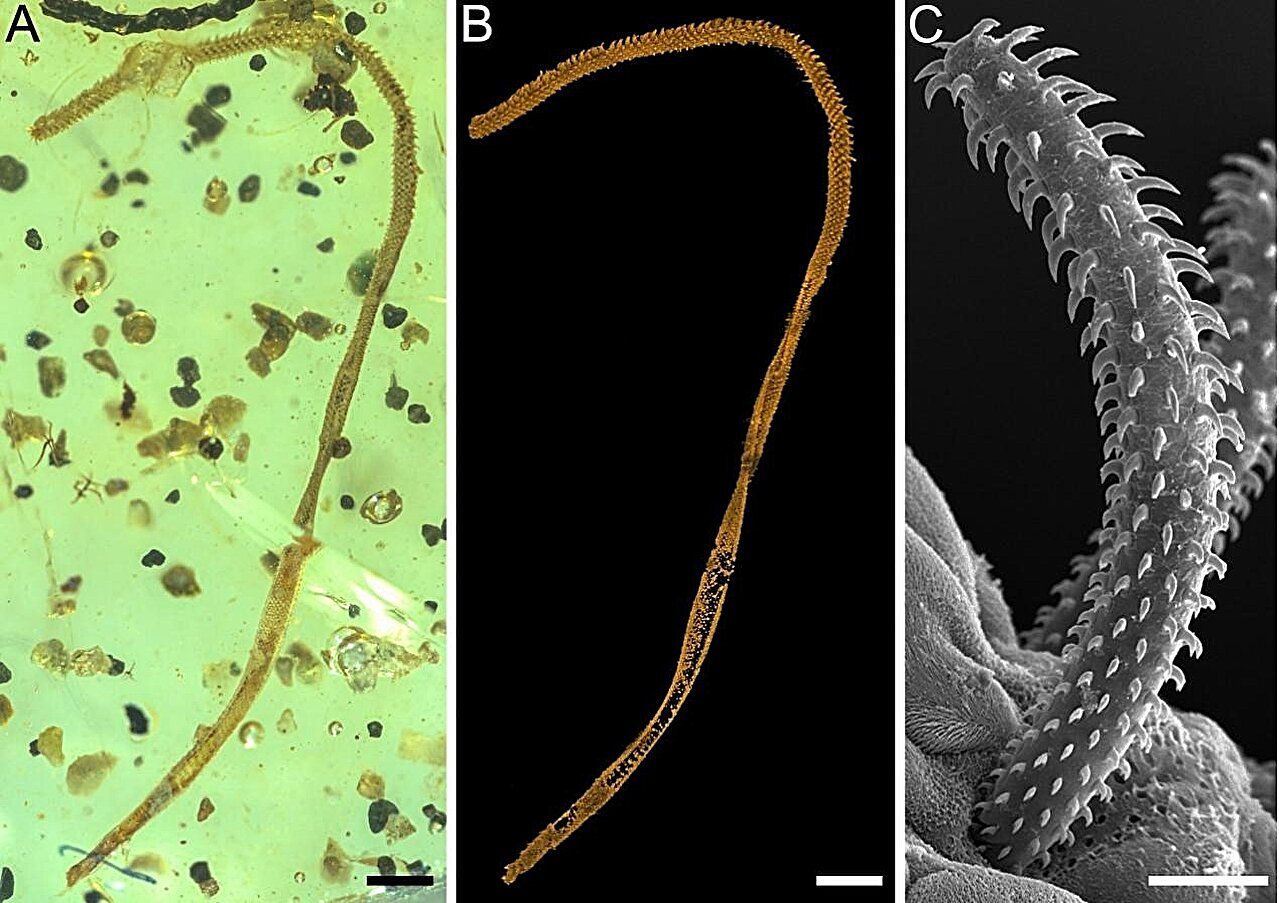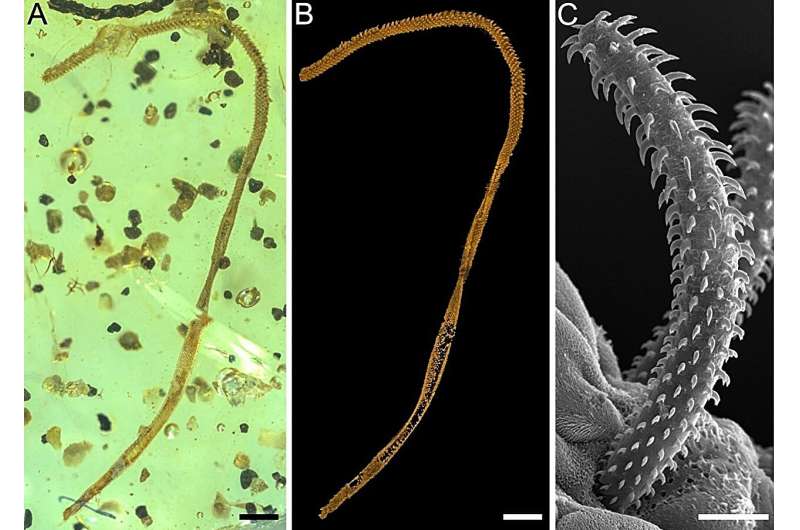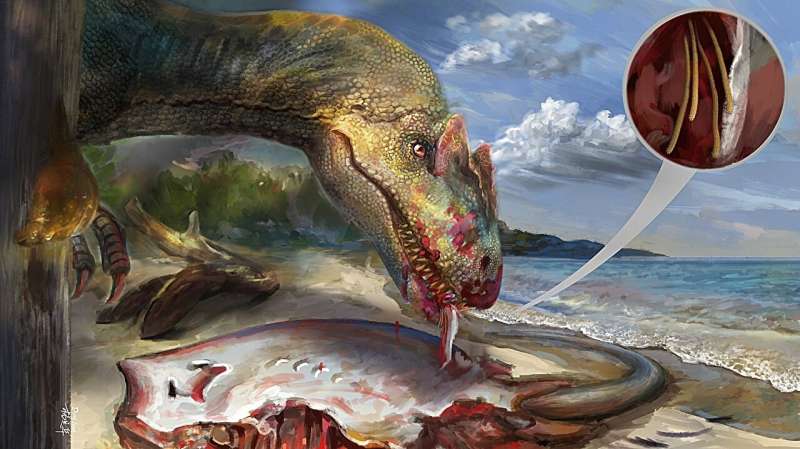

Cestoda, commonly known as tapeworms, is a large class within the platyhelminth phylum with about 5,000 species described so far. Recently, researchers from the Nanjing Institute of Geology and Paleontology of the Chinese Academy of Sciences (NIGPAS), in collaboration with scientists from Yunnan University, Germany, the U.K., and Myanmar, have reported an enigmatic fossil from mid-Cretaceous Kachin amber, dating to about 100 million years ago.
This study, published in Geology on March 22, provides evidence not only of the first partial body fossil of a tapeworm but also, arguably, the most convincing body fossil of a flatworm, thus providing new information on the early evolution of tapeworms.
Cestoda infect all major groups of vertebrates, including humans and livestock, and are found in nearly all marine, freshwater, and terrestrial ecosystems. Their size is variable, ranging from less than one millimeter to more than 30 meters in length.
Tapeworms are usually characterized by adults with a scolex (grasping head), a short neck, and a segmented body consisting of multiple sets of genitalia (proglottids). Their scolex typically has hooks, suckers, or hooked tentacles that help them cling to the alimentary tract of their hosts. Most tapeworms have an obligate parasitic life cycle involving two or three hosts. They have no mouth or digestive tract, and absorb nutrients directly from the intestines of their hosts.
The order Trypanorhyncha is the most diverse tapeworm group in the marine realm and comprises one of the most ubiquitous and readily recognized parasites of marine fish. Trypanorhynch tapeworms are characterized by a scolex with two or four bothria and a unique tentacular apparatus with four evaginable tentacles adorned with hooks as extensions of the tentacle sheaths within the scolex. Their larvae infect a wide range of marine invertebrates (e.g., crustaceans) and teleosts, and their adults are found in the stomachs and intestines of sharks and rays.
Molecular clock analyses calibrated against host fossil data estimate that trypanorhynch tapeworms probably originated around the Triassic/Jurassic boundary about 200 million years ago, but their own fossils have never been found.
“The fossil record of tapeworms is extremely sparse due to their soft tissues and endoparasitic habitats, which greatly hampers our understanding of their early evolution,” said Wang Bo, the study’s lead researcher. However, he added that his team had “reported the first body fossil of a tapeworm.”
According to the researchers, this fossil displays unique external and internal features that are most consistent with the tentacles, including the hook morphology, of extant trypanorhynch tapeworms that parasitize marine elasmobranchs (mainly sharks and rays). Remarkably, almost all extant trypanorhynchs are endoparasites of marine elasmobranchs.
Presumed tapeworm eggs have been reported from a Carboniferous shark coprolite. However, the only widely accepted fossil record prior to the Quaternary is limited to eggs discovered in a Permian shark coprolite, suggesting that the relationship between tapeworms and elasmobranch vertebrates had already been established by then. Although a tapeworm embryo inside an egg has been reported, it is questionable due to a lack of confirmed characteristics.

As for actual tapeworm fossils, the oldest supposed record comes from the Devonian of Latvia, when circlets of hooks with sucking disks were found on placoderm and acanthodian fishes. Although the arrangement of the hooks is consistent with extant monogeneans, no other body structure was found. In addition, two cysts resembling trematode metacercariae were reported from mid-Cretaceous Kachin amber, but no valid morphological details were provided to support this claim.
Similarly, a supposed body fossil of Rhabdocoela discovered in Eocene Baltic amber was plausibly reinterpreted as air bubbles. “This makes the current find the most convincing body fossil of a platyhelminth ever found,” said Luo Cihang, first author of the study and a Ph.D. candidate from NIGPAS.
This study, which provides an exceptional example of a marine endoparasite trapped in amber, has also shed new light on the taphonomy of amber.
Specifically, the researchers showed that amber can preserve the internal structure of helminths. Using high-resolution micro-CT, they discovered that the interior of the current fossil has a folded longitudinal structure that appears to run in a spiral around the longitudinal axis and extends to the anteriormost part.
This is consistent with the invaginated tentacle of a trypanorhynch. Meanwhile, the rootless hooks are also the same as those of trypanorhynchs. Previous studies had shown that internal structures could be preserved intact as in extant forms, but such studies all focused on arthropods.
“Our results show that amber can preserve the internal structure of helminths such as tapeworms on geologic time scales,” said Wang.
Along with the remarkable example of a marine endoparasite trapped in amber, some gleicheniacean trichomes and a scale insect nymph were also preserved with the partial worm fossil in the same amber specimen. This clearly indicates a terrestrial or onshore environment at the time of entrapment in resin. In addition, many sand grains were evenly distributed throughout the amber, suggesting that the fossil was entombed in a sandy environment. Furthermore, previous evidence shows that the Kachin amber was deposited in a near-shore environment.
One possible scenario for the deposition of the tapeworm in the amber is that its elasmobranch host was stranded by a tide or storm. Under such a scenario, the host was then bitten by a higher-level terrestrial predator or scavenger. When the host was ingested by the predator, the tentacle was pulled away, dislodged from the intestine, and stuck to nearby resin.
“Our study further supports the hypothesis that the Kachin amber was probably deposited in a paralic paleoenvironment, and also highlights the importance of amber research in paleoparasitology,” said Wang.
More information:
Cihang Luo et al, Exceptional preservation of a marine tapeworm tentacle in Cretaceous amber, Geology (2024). DOI: 10.1130/G52071.1
Provided by
Chinese Academy of Sciences
Citation:
Scientists discover endoparasitic marine tapeworm trapped in Cretaceous amber (2024, March 27)
retrieved 27 March 2024
from https://phys.org/news/2024-03-scientists-endoparasitic-marine-tapeworm-cretaceous.html
This document is subject to copyright. Apart from any fair dealing for the purpose of private study or research, no
part may be reproduced without the written permission. The content is provided for information purposes only.

